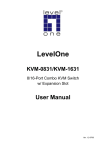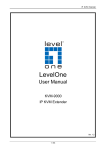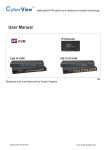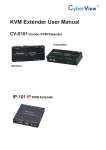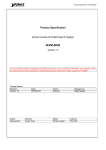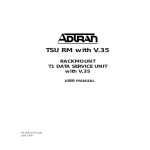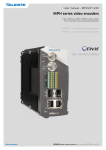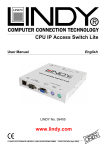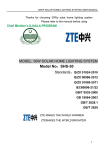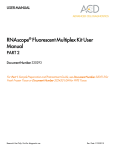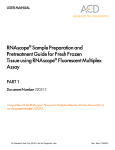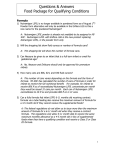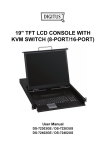Download User`s Manual ICF-1700 - PLANET Technology Corporation.
Transcript
8/16-Port IP KVM Switch
IKVM-8020
ademarks
Copyright © PLANET Technology Corp. 2012.
Contents subject to revise without prior notice.
PLANET is a registered trademark of PLANET Technology Corp.
respective owners.
All other trademarks belong to their
Disclaimer
PLANET Technology does not warrant that the hardware will work properly in all environments and
applications, and makes no warranty and representation, either implied or expressed, with respect to the
quality, performance, merchantability, or fitness for a par
particular
ticular purpose.
KVMdisclaims
Over liability
PLANET has made every effort to ensure that this User’s
User8-Port
’s Manual isCombo
accurate; PLANET
liability for
any inaccuracies or omissions that may have occurred. IP Switch
without notice and does
Information in this User’s Manual is subject to change without
does not represent a commitment on
the part of PLANET. PLANET assumes no responsibility for any inaccuracies that may be contained in this
User’s Manual. PLANET makes no commitment to update IKVM-8020
or keep current the information in this User’s
Manual, and reserves the right to make improvements to this User’s Manual and/or to the products described
in this User’s Manual, at any time without notice.
If you find information in this manual that is incorrect, misleading, or incomplete, we would appreciate your
comments and suggestions.
FCC Warning
This equipment has been tested and found to comply with the limits for a Class A digital device, pursuant to
Part 15 of the FCC Rules. These limits are designed to provide reasonable protection against harmful
interference when the equipment is operated in a commercial environment. This equipment generates, uses,
and can radiate radio frequency energy and, if not installed and used in accordance with the Instruction
manual, may cause harmful interference to radio communications. Operation of this equipment in a residential
area is likely to cause harmful interference in which case the user will be required to correct the interference at
his own expense.
CE Mark Warning
This is a Class A product. In a domestic environment, this product may cause radio interference, in which case
the user may be required to take adequate measures.
Revision
PLANET 8-Port IP KVM Switch User's Manual
For Model: IKVM-8020
Revision: 1.0
Part No.: EM-IKVM8020
8-port Combo KVM Over IP Switch
IKVM-8020
Copyright
Copyright © 2013 by PLANET Technology Corp. All rights reserved. No part of this publication may be
reproduced, transmitted, transcribed, stored in a retrieval system, or translated into any language or computer
language, in any form or by any means, electronic, mechanical, magnetic, optical, chemical, manual or
otherwise, without the prior written permission of PLANET.
PLANET makes no representations or warranties, either expressed or implied, with respect to the contents
hereof and specifically disclaims any warranties, merchantability or fitness for any particular purpose. Any
software described in this manual is sold or licensed "as is". Should the programs prove defective following
their purchase, the buyer (and not PLANET, its distributor, or its dealer) assumes the entire cost of all
necessary servicing, repair, and any incidental or consequential damages resulting from any defect in the
software. Further, PLANET reserves the right to revise this publication and to make changes from time to time
in the contents hereof without obligation to notify any person of such revision or changes.
All brand and product names mentioned in this manual are trademarks and/or registered trademarks of their
respective holders.
Federal Communication Commission Interference Statement
This equipment has been tested and found to comply with the limits for a Class B digital device, pursuant to
Part 15 of FCC Rules. These limits are designed to provide reasonable protection against harmful interference
in a residential installation. This equipment generates, uses, and can radiate radio frequency energy and, if
not installed and used in accordance with the instructions, may cause harmful interference to radio
communications. However, there is no guarantee that interference will not occur in a particular installation. If
this equipment does cause harmful interference to radio or television reception, which can be determined by
turning the equipment off and on, the user is encouraged to try to correct the interference by one or more of
the following measures:
1. Reorient or relocate the receiving antenna.
2. Increase the separation between the equipment and receiver.
3. Connect the equipment into an outlet on a circuit different from that to which the receiver is connected.
4. Consult the dealer or an experienced radio technician for help.
FCC Caution
To assure continued compliance. (example-use only shielded interface cables when connecting to computer
or peripheral devices). Any changes or modifications not expressly approved by the party responsible for
compliance could void the user’s authority to operate the equipment.
This device complies with Part 15 of the FCC Rules. Operation is subject to the Following two conditions: ( 1 )
This device may not cause harmful interference, and ( 2 ) this Device must accept any interference received,
including interference that may cause undesired operation.
Federal Communication Commission (FCC) Radiation Exposure Statement
This equipment complies with FCC radiation exposure set forth for an uncontrolled environment. In order to
avoid the possibility of exceeding the FCC radio frequency exposure limits, human proximity to the antenna
shall not be less than 20 cm (8 inches) during normal operation.
2
8-port Combo KVM Over IP Switch
IKVM-8020
Safety
This equipment is designed with the utmost care for the safety of those who install and use it. However,
special attention must be paid to the dangers of electric shock and static electricity when working with
electrical equipment. All guidelines of this and of the computer manufacture must therefore be allowed at all
times to ensure the safe use of the equipment.
CE Mark Warning
This is a Class B product. In a domestic environment, this product may cause radio interference, in which case
the user may be required to take adequate measures.
WEEE Regulation
To avoid the potential effects on the environment and human health as a result of the presence of
hazardous substances in electrical and electronic equipment, end users of electrical and electronic
equipment should understand the meaning of the crossed-out wheeled bin symbol. Do not dispose
of WEEE as unsorted municipal
waste and have to collect such WEEE separately.
Revision
User’s Manual for PLANET 8-Port Combo KVM over IP switch
Model: IKVM-8020
Rev: 1.00 (January.2013)
Part No. EM-IKVM-8020
3
8-port Combo KVM Over IP Switch
IKVM-8020
Table of Contents
CHAPTER 1 INRODUCTION .....................................................................................................................................5
1.1 Features....................................................................................................................................................................7
1.2 Package Contents.....................................................................................................................................................7
1.3 Technical Specifications ..........................................................................................................................................8
CHAPTER 2 INSTALLATION.....................................................................................................................................9
2.1 System Requirements ..............................................................................................................................................9
2.2 Cable Diagrams .......................................................................................................................................................9
2.3 Product Details ......................................................................................................................................................10
2.4 Hardware Installation.............................................................................................................................................11
2.5 Cascade Chain Connection Diagram .....................................................................................................................13
CHAPTER 3 Operations..............................................................................................................................................15
3.1 Manual Key ...........................................................................................................................................................15
3.2 Hot Key and Mouse Clicking ................................................................................................................................15
3.3 OSD (On Screen Display) .....................................................................................................................................15
Chapter 4 Remote Usage .............................................................................................................................................24
4.1 Prerequisite ............................................................................................................................................................24
4.2 Login and Logout ..................................................................................................................................................25
4.2.1 Login...................................................................................................................................................................25
4.2.2. Logout................................................................................................................................................................27
4.3 The Remote Console..............................................................................................................................................27
4.3.1 Remote Console Control Bar..............................................................................................................................28
4.3.2 Remote Console Status Line...............................................................................................................................33
Chapter 5 Menu Options .............................................................................................................................................34
5.1 Remote Control......................................................................................................................................................34
5.1.1 KVM Console.....................................................................................................................................................34
5.1.2 Telnet/SSH Console............................................................................................................................................34
5.1.3 Remote Wakeup..................................................................................................................................................35
5.2 Virtual Media .........................................................................................................................................................38
5.2.1 Drive Redirection................................................................................................................................................39
5.2.2 Virtual Drive .......................................................................................................................................................40
5.2.3 CD/DVD Image ..................................................................................................................................................40
5.3 User Management..................................................................................................................................................42
5.3.1 Change Password................................................................................................................................................42
5.3.2 Users ...................................................................................................................................................................42
5.4 KVM Settings ........................................................................................................................................................44
5.4.1 User Console.......................................................................................................................................................44
5.4.2 Keyboard/Mouse.................................................................................................................................................47
5.4.3 Video...................................................................................................................................................................48
5.5 Device Settings ......................................................................................................................................................49
5.5.1 Network ..............................................................................................................................................................49
5.5.2 Dynamic DNS.....................................................................................................................................................52
5.5.3 Security...............................................................................................................................................................54
5.5.4 Certificate ...........................................................................................................................................................56
5.5.5 Serial Port ...........................................................................................................................................................57
5.5.6 Date / Time .........................................................................................................................................................57
5.5.7 Event Log ...........................................................................................................................................................59
5.5.8 Authentication.....................................................................................................................................................60
5.5.9 USB ....................................................................................................................................................................61
5.5.10 Config File........................................................................................................................................................61
5.6 Maintenance...........................................................................................................................................................61
5.6.1 Device Information.............................................................................................................................................62
5.6.2 Even log..............................................................................................................................................................63
5.6.3 Unit Reset ...........................................................................................................................................................63
Appendix A Cable Connectors Specifications .............................................................................................................65
Appendix B Troubleshooting & Frequently Asked Questions.....................................................................................66
4
8-port Combo KVM Over IP Switch
IKVM-8020
CHAPTER 1 INRODUCTION
Easily Control Servers with Flexibility
The PLANET 8-Port Combo IP KVM Switch, IKVM-8020 is an enterprise-class, secure,
KVM-over-IP switch that provides BIOS-level control of up to 64 servers. Use a dedicated
micro-controller and potentially specialized video capture hardware to capture the video,
keyboard, and mouse signals, compress and convert them into packets, and send them over
an Ethernet link to a remote console application that unpacks and reconstitutes the dynamic
graphical image. This IP KVM solution includes standard features such as Powerful Mouse /
Keyboard Support such as installing software, transferring files and backing up data.
Powerful VGA / Mouse / Keyboard Support
The IKVM-8020 will detect the current video mode of the console automatically; and manual
fine-tuning is also available to receive an optimal video quality. The IKVM-8020 will accept
video streams with a dot clock rate up to 110MHz, therefore, the remote VGA resolution can
up to 1600 x 1200 video resolutions.
User can connect up to 8 PCs to the IKVM-8020. The IKVM-8020 also fully supports various
models of PS/2 and USB mice manufactured by Logitech, Microsoft and IBM as well as
compatible PS/2 and USB mice of other brands. The KVM supports the PS/2 and USB
Keyboard Port of the CODE SET1/2/3 and further allows you to use the KVM for all kinds of
servers and PCs.
5
8-port Combo KVM Over IP Switch
IKVM-8020
Easy Switching , Efficient Management
The IKVM-8020 can fully control the connected PCs of any platform through any at-hand
browser or just work as a normal 8-Port KVM Switch in local site. By the support of daisy
chain function, users can cascade one IKVM-8020 to multiple KVM-810 or KVM-1610, and
manage this KVM chain with one single IP. The IKVM-8020 is the ideal choice for those users
who want to maintain their PC system at office or home 24/7.
6
8-port Combo KVM Over IP Switch
IKVM-8020
1.1 Features
Hardware
19” rack mount 1U size design
LED display for easy status monitoring
Built-in one extra daisy chain port to cascade with KVM-810 and KVM-1610
High Video Resolution up to 1920 x 1440 (local side) or 1600 x 1200 (remote side)
Supports hot plug; no need to power off the KVM switch or PCs when adding or
removing PCs
System
Supports SSL protocol for any encrypted network traffic between itself and a
connected client
Automatically senses video resolution for best possible screen capture
No Software Required:easy PC selection via On Screen Display (OSD) menu, Push
Buttons, Hot Keys
Compliant with DOS, Windows, Netware, Unix, Linux, iMAC, Power MAC and Sun
Micro Systems with USB port by connecting with a USB-PS/2 adapter
Installation
Remote mass storage control
Supports password protection and PC server name search
Buzzer sound for switching port confirmation
Keyboard status restored when switching PCs
1.2 Package Contents
♦
♦
♦
♦
♦
♦
♦
♦
1 x 8-port KVM switch
1 x User's Manual
1 x CD-ROM
1 x Adaptor (for US. EU. UK. AU type)
2 x KVM Cable (3-in-1 KVM Cable for Computer side)
2 x Rack Mount Kit
6 x Rack Mount Screw
4 x Pad
1. If any of the above items are missing, please contact your dealer
immediately.
2. Using the power supply that is not the one included in unit packet will
cause damage and void the warranty for this product.
7
8-port Combo KVM Over IP Switch
IKVM-8020
1.3 Technical Specifications
Model
IKVM-8020
Hardware Interface
PC Port
Host Connectors
(all female type)
Local Console Connectors
(all female type)
Daisy Chain Connectors
(all female type)
Remote Console
8
HDDB 15-pin x 8
USB keyboard port & USB mouse port
PS/2 keyboard port & PS/2 mouse port
HDDB 15-pin VGA port
PS/2 keyboard port
PS/2 mouse port
HDDB 15-pin VGA port
10/100 Mbps Ethernet, RJ-45
Control Feature
Max connected PCs
64 (by cascade 8 KVM-810)
Max cascade levels
2
Port Selection Keys
8
PC Selection
On Screen Display Menu / Hot Key / Button
VGA Resolution
Local console: 1920 x 1440
Remote console: 1600 x 1200
Network and Configuration
Network Standard
Supported Protocol
IEEE 802.3 10Base-T
IEEE 802.3u 100Base-TX
TCP, IP, ARP, ICMP, HTTP/HTTPS, Telnet, SSH, DHCP/BOOTP, PPP,
SMTP, DNS, NTP, Dynamic DNS
Client Software
Microsoft Java VM, Sun Java VM (Plug in), Netscape Java VM
Remote Access Key
128-bit SSL / 256-bit SSL(Firefox)
Keyboard / mouse Emulation
USB & PS/2
DDC / EDID communication
DDC2
Environment
Dimension (W x D x H)
160 x 444.5 x 44.3 mm
Weight
2.76kg
Environmental Specification
Operating temperature: 0 ~ 50 Degree C
8
8-port Combo KVM Over IP Switch
IKVM-8020
Storage temperature: -20 ~ 60 Degree C
Relative humanity: 0 ~ 80% (non-condensing)
Power Requirement
12V DC, 1.5A
Electromagnetic Compatibility
FCC, CE
CHAPTER 2 INSTALLATION
2.1 System Requirements
IKVM-8020
Description
Console side
Computer side
[Optional]
8-Port Combo KVM Switch
One VGA Monitor
One PS/2 Keyboard
One PS/2 Mouse
One USB Keyboard
One USB Mouse
8 * 3-in-1 KVM Cable (VGA / Keyboard / Mouse )
2.2 Cable Diagrams
3-in-1 KVM Cable is for PS2 Computer or Server; connected USB PC or
Server, Please use PS2 to USB Adapter
Connected to CPU port of KVM
Connected to Console port of PC or Slave
PS/2 Cable:
Mini Din 6 pin Male to Male
,
AT to PS/2 keyboard adapter: (Optional)
Din 5 pin Male to Mini Din 6 pin Female
9
8-port Combo KVM Over IP Switch
IKVM-8020
VGA Cable:
HDB15 pin Male to Male
PS2 to DB9 adapter: (Optional)
Mini Din 6 pin Female to DB 9 pin Female
2.3 Product Details
Front panel
LEDs
Color
Description
Power
Blue
A blue light indicates that the KVM is operating.
Green
The PC or KVM connected to the corresponding port is
on and operating.
Red
The situation of being connected to the port.
Port
Button
OSD
Description
OSD Control Mode.
Console-Reconfirmed
The keyboard and mouse will be reconnected, and
the EDID in the screen will be read again.
Real panel
10
8-port Combo KVM Over IP Switch
IKVM-8020
Port
CPU
Description
Install the cable connected to a PC here.
Console
♦In the Master KVM, connect the monitor, keyboard and mouse
here.
♦In the Slave KVM, connect the cable come from the Master
CPU port here.
2.4 Hardware Installation
Before installation, please make sure all of peripherals and computers
have been turned off.
Step 1 Rack Installation
Find a convenient place to put your KVM Switch. Its 19” rack mount form factor
makes it ideal stackable on 19” rack. When stacking to a rack, attach the
included brackets to the sides of the KVM Switch. Take note of the length of
your cables so that your computers, KVM Switch, keyboard, mouse and
monitor are distanced properly.
Step 2 Connecting Monitor to the KVM Switch
Connect the monitor to the KVM Switch. Using the attached cable, or the one
included with your monitor, connect it to the HDDB-15 female port on the back
of the KVM unit labeled with the monitor symbol at the CONSOLE port
connector.
Step 3 Connecting Keyboard to the KVM Switch
Connect the keyboard and mouse to the KVM Switch. If you have an AT type
keyboard, you will need an AT to PS/2 adapter.
Step 4 Connecting Mouse to the KVM Switch
Connect the mouse to the KVM Switch.
Step 5 Connecting VGA/Mouse/Keyboard port of PC(s) to the KVM
Switch
Install the Master KVM to the 3-in-1 cable (same as the cable for connecting
the KVM to the PC) in the middle of the Slave KVMs.
11
8-port Combo KVM Over IP Switch
IKVM-8020
The rear side of PC
Step 6 Check Again
Double-check all of the connections. You can check the color of keyboard and
mouse connector to make sure the keyboard and mouse cables go to the
correct ports.
Step 7 Connecting Other PCs
Repeat step 5 for the remainder of the computers.
Step 8 Connecting KVM Power
Attach the power supply to the KVM unit and plug the other end into an
electrical receptacle. Now you will see the LED for Port 1 light up, and you will
hear a beep. Switch on your monitor.
It is not necessary to power down the whole system for install a new PC
or KVM thereafter. All you need is to make sure that the new PC or KVM
is OFF during the installation. If the KVM powers down due to external
Factors (such as power failure or the power of the KVM is turned off), we
recommend you to reinstall the whole system.
12
8-port Combo KVM Over IP Switch
IKVM-8020
2.5 Cascade Chain Connection Diagram
Step 1 Rack Installation
Find a convenient place to put your KVM Switch. Its 19” rack mount form factor
makes it ideal stackable on 19” rack. When stacking to a rack, attach the
included brackets to the sides of the KVM Switch. Take note of the length of
your cables so that your computers, KVM Switch, keyboard, mouse and
monitor are distanced properly.
Step 2 Connecting Monitor to the KVM Switch
Connect the monitor to the KVM Switch. Using the attached cable, or the one
included with your monitor, connect it to the HDDB-15 female port on the back
of the KVM unit labeled with the monitor symbol at the CONSOLE port
connector.
Step 3 Connecting Keyboard to the KVM Switch
Connect the keyboard and mouse to the KVM Switch. If you have an AT type
keyboard, you will need an AT to PS/2 adapter.
Step 4 Connecting Mouse to the KVM Switch
Connect the mouse to the KVM Switch.
Step 5 Connecting console port of KVM to the KVM Switch
Use the 3-in-1 cable(or with PS2 to USB Adaptor) to connect the CPU port of
the master KVM in parallel to the console port of the slave KVM.
13
8-port Combo KVM Over IP Switch
IKVM-8020
Step 6 Connecting VGA/Mouse/Keyboard port of PC(s) to the KVM
Switch
Install the Master KVM to the 3-in-1 cable (same as the cable for connecting
the KVM to the PC) in the middle of the Slave KVMs.
The rear side of PC
Step 7 Check Again
Double-check all of the connections. You can check the color of keyboard and
mouse connector to make sure the keyboard and mouse cables go to the
correct ports.
Step 8 Connecting Other PCs
Repeat step 5 - 6 for the remainder of the computers.
Step 9 Connecting KVM Power
Attach the power supply to the KVM unit and plug the other end into an
electrical receptacle. Now you will see the LED for Port 1 light up, and you will
hear a beep. Switch on your monitor.
14
8-port Combo KVM Over IP Switch
IKVM-8020
CHAPTER 3 Operations
3.1 Manual Key
It is the simplest switching method. You just need to press the Port Selection
Switch on the front panel of the KVM. The Selection LED (Red) is on,
indicating that you are switching to the corresponding port.
1. The Port Selection Switch functions only when connected to a PC.
2. If the Offline Skip of the OSD System Setting is Auto, then you cannot
make any switch when pressing an offline Port Selection switch.
3. For Auto Scan Mode, none of the Port Selection Switches functions
3.2 Hot Key and Mouse Clicking
Hot key and mouse clicking are applicable for switching a small section.
You can select the SVS (Smart View Setting) from the OSD of the PC first
(for a quick switch of PC) and use the keyboard (press the Ctrl key twice)
or the mouse (press and hold the middle button while pressing the left or
right button) to switch to the previous or next set of PC.
The mouse must have at least 3 keys. As far as you select a PC with the SVS,
you can use this method for the switch.
3.3 OSD (On Screen Display)
Press the NumLock on the keyboard twice or simultaneously press the
Push Buttons 1 and 2 of the Port Selection Switch on the KVM panel to
start the OSD. Use the key Up, Down and Enter keys on the keyboard to
switch or directly move the mouse to the target PC, and then double click
the left button.
Additionally, you also can use the numeric keys to enter the direct switch.
For example, if you want to switch a PC to the Slave KVM port 04 under
the Master KVM port 03, then you can start the OSD and then directly
enter 0304. If you are using a standalone machine, then just enter the first
two digits.
More OSD related information is given in the following OSD sections.
15
8-port Combo KVM Over IP Switch
IKVM-8020
Start
Press the NumLock twice or the Port Selection Switches 1 and 2 on the
panel to enter the OSD.
If you have modified the Hot Key for starting the OSD and are unable to
enter the OSD by pressing NumLock, and then you can start the OSD by
using Port Selection Switch first, and then press F9 to enter into the
System Setting to modify the options of the OSD Entry Hot Key.
If you have modified the Hot Key for starting the OSD and are unable to
enter the OSD by pressing NumLock, then you can start the OSD by using
the Port Selection Switch first, and then press F9 to enter into the System
Setting to modify the options of the OSD Entry Hot Key.
Operation
You can operate the options by keyboard or mouse. For the keyboard
operation, besides the common Up and Down keys, there are special
function keys such as Enter, Space Bar, Function Key (F1, F4…) under the
OSD remark field. For the mouse operation, the left key refers to Enter and
the right key refers to Exit. For example, move the mouse point to your
desired PC, and click the left key. The selection bar will move to that
position and then click the left key again for the execution.
You must use the keyboard to complete the two functions: Name Edit and
Password.
16
8-port Combo KVM Over IP Switch
IKVM-8020
Switch Menu
Master List
1
2
03-04:Mail Ser 4
LIST: MASTER
PWR
C#
KVM
●
●
01
02
●
03
04
05
06
07
08
3
●
●
●
4
NAME
Admin
04
08
16
Mail Group
Peter
Web Group
Data Group
SVS
♁
Θ
Ο
Θ
♁
Ο
Ο
Θ
Press
Enter
) *↑↓: Move
Space: Edit
Esc: Exit
F1: Smart View
Enter: Switching
F4: Auto Scan
F9: System Setting
F5: Clear Name List
Slave List
03-04:Mail Ser 4
LIST: Mail Group
PWR
C#
KVM
●
01
●
02
●
03
●
04
NAME
Mail Ser 1
Mail Ser 2
Mail Ser 3
Mail Ser 4
SVS
Θ
Θ
♁
♁
) *↑↓: Move
Space: Edit
Esc: Exit
F1: Smart View
Enter: Switching
F4: Auto Scan
F9: System Setting
F5: Clear Name List
1. This field provides the information of the currently connected PC. As
shown in the figure above, 03 refer to the Port Number of the Master; 04
refer the Port Number of the Slave; and Mail Ser 4 is the name of this
PC defined by Users. If a PC connects to the Master, then the number
consists of the first two digits. If a User has not given a name for the PC,
the name field will be blank.
17
8-port Combo KVM Over IP Switch
IKVM-8020
2. This field shows the list of the Master KVM or a certain set of Slave KVM
currently displayed on the OSD. We recommend you to give a name to
the Slave KVM, or else the display after LIST: will be blank.
3. This field shows the list of connections to the KVM, and the fields are
described below: PWR: It shows the status of power supply and
indicates a normal power supply for the equipment (PC or KVM)
connected to the CPU port.
C#: It shows the channel number; the KVM-810 will display 01~08 and the KVM-1610
will display 01~08; 09~16 (Since the screen cannot display all at a time, therefore
you can use PgUp / PgDn to switch the pages).
KVM: It shows the KVM model. If there is a number in this field, it shows that a
set of KVM connects to this port. The number 04 indicates Port 4 and 08
indicates Port 8 and 16 indicates Port 16 and so on.
If the connected KVM is not on, there will have no number in this
field.
NAME: It shows the name of the equipment, and users can name the Slave
KVM or PC on their own. There are a total of 12 characters selected from the
group of “A~Z”, “a~z”, “0~9” , “+”, “-” , “*”, “/” , “=”, “[”,“]”, “,”, “.”, “:”.
Please use the CapsLock to toggle the upper and lower cases.
SVS: It shows the Smart View Setting; use ♁ to open and Θ to close. The
SVS is blank and not clickable if the KVM is connected in parallel. If this option
is set to open, then you can make the switch by operating the Hot Key Switch
or Mouse Clicking or selecting the option by Auto Scan. You also can use
mouse to click this field.
18
8-port Combo KVM Over IP Switch
IKVM-8020
Selection BAR: It shows the selection bar (Green); you can use the ↑↓ keys on
the board to move the selection bar, and the situated position indicates the
selected target for giving instructions. For example, if the selection bar points at
C#05 and you press Enter, then the system will switch to that particular PC or
press the “Space BAR” to start editing the name. Press F4 to enable/disable
the SVS option.
4、Instruction Hint Field:
) *↑↓:
Use the ↑↓ keys on the keyboard or the mouse to move the selection
(Move)
bar
SPACE:
The “Space BAR” on the keyboard is used to start editing the name of
(Edit)
the PC or KVM.
ESC:
Use the “Esc” key on the keyboard to exit the current option or exit
(Exit)
OSD.
F4:
Use the F4 key to run Auto Scan, and you can set the residing time,
(Auto Scan)
channel display time and mode of the Auto Scan from System Setting.
F9:
(System Setting)
Use the F9 key to enter into the System Setting Menu.
F5:
Use the F5 key to clear the values of all Name fields. If you clear the
(Clear Name List)
name list under the Master screen, then you will also clear the name
lists under all slaves. If you clear the name list under a certain slave,
then you only clear the name list under that particular Slave KVM.
F1:
(Smart View)
It switches the Smart View Setting.
19
8-port Combo KVM Over IP Switch
IKVM-8020
System Setting Menu
System Setting
Channel Display Mode
Full
Channel Display Tim
5 Sec
Auto Scan Time
5 Sec
OSD Entry Hot Key
Number Lock
Hot Key Switching
OFF
Mouse Clicking
OFF
Beeper Sound
ON
Offline Skip
Manual
OSD Language
English
Security Level
None
Console Lock Time
5 Min
↑↓
Move
Space
Change
Esc
Exit
F1
Information
F4
OSD Position
F8
Restore Default Setting
20
8-port Combo KVM Over IP Switch
IKVM-8020
Item
Channel Display
Mode
Channel Display Time
Auto Scan Time
OSD Entry Hot Key
Hot Key Switching
Description
Default
For Port Switching, Auto Scan and OSD
Close, the Monitor will show the Channel
Full
information and mode selection.
It shows the time for displaying channel
information.
For Auto Scan, it shows the residing time for
each port.
Select to turn on the hot keys of the OSD
control screen.
Turn on/off the “Ctrl” hot keys on the
5 Sec
5 Sec
NumLock
Other Selection
Number,
Name
10Sec, Always,
None
10Sec, 20Sec,
30Sec, 60Sec
Scroll Lock,
Shift, None
OFF
ON
OFF
ON
Turn on/off the beeper sound function.
ON
OFF
Set the offline skip function to auto or manual.
Manual
Auto
OSD Language
Select the language for the OSD.
English
Security Level
Select the security mode and level.
None
The lock time of console port.
5 Min
Mouse Clicking
Beeper Sound
Offline Skip
Console Lock Time *1
keyboard for switching computer functions.
Turn on/off the keys of the mouse for
switching computer functions.
*1: You can select this option only if the Security Level is not “None”.
21
Francis, Deutsch,
Italian, Espino
Low, High
1Min, 3Min, 10Min,
30Min, 60Min
8-port Combo KVM Over IP Switch
IKVM-8020
F1: Information; It provides the model name and F/W version information,
which is helpful for users to understand the updated version.
F4: OSD Position; you can enter the OSD position to make adjustments; we
recommend you to unify the resolution for all computer display mode, and use
this function again to adjust the OSD position. You can use the Up, Down, Left
or Right keys on the keyboard or a mouse to move the OSD position.
F8: Restore Default Setting; Restore the factory default settings. Please note
that all name lists will be cleared and the system settings are set to the default
settings as shown in the table above.
Esc: Exit; Exit the system setting and close the OSD. If you have made
changes in this option, the system will ask whether or not you want to save the
setting before the selected option is effective.
Auto Scan Mode: You can start the OSD first and press “F4” to enter the Auto
Scan Mode. If you want to scan the PC, you must use the Smart View Setting
to select the Auto Scan Time in the System Setting for the residing time, which
includes 5 sec, 10 sec, 20 sec, 30 sec and 60 sec. You can adjust the Channel
Display Mode and Channel Display Time from the Channel Display mode. By
then, all keys on the panel, keyboard and mouse are not operable. You can
only use the ESC key to exit the Auto Scan Mode.
22
8-port Combo KVM Over IP Switch
IKVM-8020
Security Mode: Switch the Security Level from “None” to “Low” in the System
Setting, and enter your Password (“A~Z”, “0~9”, a maximum of 12 characters),
and the security will be effective after you confirm the Password. The use of the
Console Lock Time is to set the time to enter a security mode after the
keyboard and mouse has idled for a predetermined time. Once you enter into
the security mode, you need to enter the correct password before you can
move the mouse or enter any key from the keyboard. You need a correct
password to operate the whole system normally.
Important Note: What should I do if I forgot my Password?
After you enter a wrong password for 5 consecutive times, a time delay bar will
appear, and a set of “Magic Numbers” will show up at the bottom.
Record the magic numbers and contact with your distributor.
Console - Reconfirmed: Simultaneously press the largest two numbered Port
Selection Switches on the panel to start the Console- Reconfirmed. If you
change the Console equipment, please use this function to let KVM reconfirm
the equipment at the Console end once.
EDID & DDC: A vast majority of computer monitors supports the Extended Display
Identification Data (EDID) and allows data access by Display Data Channel (DDC).
The KVM also supports these two specifications, but the KVM only reads the EDID
of the Monitor when the KVM is on. If it is necessary to change monitors during an
operation, please use the Console Reconfirmed function to read the EDID again.
23
8-port Combo KVM Over IP Switch
IKVM-8020
Chapter 4 Remote Usage
4.1 Prerequisite
The IKVM-8020 feature an embedded operating system and applications
offering a variety of standardized interfaces. This chapter will describe both
these interfaces, and the way to use them in a more detailed manner. The
interfaces are accessed using the TCP/IP protocol family, thus they can be
accessed using the built-in Ethernet port.
The following interfaces are supported:
HTTP/HTTPS
The IKVM-8020 can be entirely managed using a standard web browser. You can
access the IKVM-8020 using the insecure HTTP protocol, or using the encrypted
HTTPS protocol. Whenever possible, use HTTPS.
Telnet
A standard Telnet client can be used to access an arbitrary device connected to the
IKVM-8020 port via a terminal mode.
The primary interface of the IKVM-8020 is the HTTP interface. This is covered
extensively in this chapter. Other interfaces are addressed in subtopics.
In order to use the Remote Console window of your managed host system, the
browser has to come with a Java Runtime Environment version 1.1 or higher. If the
browser has no Java support (such as on a small handheld device), you are still
able to maintain your remote host system using the administration forms displayed
by the browser itself.
Important: We recommend installing a Sun JVM 1.5 or above.
For an insecure connection to the IKVM-8020, we can recommend the following
browsers:
• Microsoft Internet Explorer version 8.0 or higher on Windows 2000, Windows XP,
Windows Server 2003 and Win7.
• Mozilla Firefox 14 on Windows 2000, Windows XP, Windows Server 2003, Win7
and Linux and other UNIX-like Operating Systems
In order to access the remote host system using a securely encrypted
connection, you need a browser that supports the HTTPS protocol. Strong
security is only assured by using a key length of 128 Bit. Some of the old
browsers do not have a strong 128 Bit encryption algorithm.
Using the Internet Explorer, open the menu entry “?” and “Info” to read about the key
length that is currently activated. The dialog box contains a link that leads you to
information on how to upgrade your browser to a state of the art encryption scheme.
The picture below shows the dialog box presented by the Internet Explorer 8.0.
24
8-port Combo KVM Over IP Switch
IKVM-8020
Newer web browsers do support strong encryption on default.
4.2 Login and Logout
4.2.1 Login
Note:
Your web browser has to accept cookies, or else login is not possible.
Launch your web browser. Direct it to the address of your IKVM-8020, which you
configured during the initial configuration. The address used might be a plain IP
address or a host and domain name, in the case where you have given your
IKVM-8020 a symbolic name in the DNS. For instance, type the following in the
address line of your browser when establishing an unsecured connection:
http://<IP address of IKVM-8020 >
When using a secure connection, type in: https://<IP address of IKVM-8020 >
This will lead you to the IKVM-8020 login page.
25
8-port Combo KVM Over IP Switch
IKVM-8020
The IKVM-8020 has a built-in super user that has all permissions to administrate
the device:
Login
name
super (in default)
Password
pass (in default)
Note: Please change the super user password immediately after the first time login
successfully. Not changing the pass phrase for the super user is a severe security
risk and might result in unauthorized access to the IKVM-8020 and to the host
system including all possible consequences!
Having logged into the IKVM-8020 successfully, the main page of the IKVM-8020
will appear.
This page consists of three parts; each of them contains specific
information. The buttons on the upper side allow you to navigate within the
front end.
Return to the main page of the IKVM-8020.
Open the IKVM-8020 remote console.
Exit from the IKVM-8020 front end.
26
8-port Combo KVM Over IP Switch
IKVM-8020
The lower left frame contains a navigation bar and allows you to switch between
the different sections of the IKVM-8020. Within the right frame, task-specific
information is displayed that depends on the section you have chosen before.
Warning: If there is no activity for half an hour, the IKVM-8020 will log you out,
automatically. A click on one of the links will bring you back to the login screen.
4.2.2. Logout
This button
logs out the current user and presents a new login screen.
Please note that an automatic logout will be performed in case there is no activity
for half an hour.
4.3 The Remote Console
Clicking on the icon
opens an additional Remote Console window. The
Remote Console window is a Java Applet that tries to establish its own TCP
connection to the IKVM-8020. The protocol that is run over this connection is
neither HTTP nor HTTPS, but RFB (Remote Frame Buffer Protocol). Currently,
RFB tries to establish a connection to port number 443. Your local network
environment has to allow this connection to be made, i.e. your firewall end, in case
you have a private internal network, your NAT (Network Address Translation)
settings have to be configured accordingly.
In case the IKVM-8020 are connected to your local network environment and your
connection to the Internet is available using a proxy server only without NAT being
configured, the Remote Console is very unlikely to be able to establish the
according connection. This is because today's web proxies are not capable of
relaying the RFB protocol.
In case of problems, please consult your network administrator in order to
provide an appropriate network environment.
Once the Remote Console is connected, it displays the screen content of your host
system. The Remote Console will behave exactly in the same way as if you were
sitting directly in front of the screen of your remote system. That means keyboard
and mouse can be used in the usual way. However, be aware of the fact that the
remote system will react to keyboard and mouse actions with a slight delay. The
delay depends on the bandwidth of the network which you use to connect to the
IKVM-8020.
With respect to the keyboard, the very exact remote representation might lead to
some confusion as your local keyboard changes its keyboard layout according to
the remote host system. If you use a German administration system, and your host
system uses a US English keyboard layout, for instance, special keys on the
German keyboard will not work as expected. Instead, the keys will result in their US
English counterpart. You can circumvent such problems by adjusting the keyboard
of your remote system to the same mapping as your local one.
27
8-port Combo KVM Over IP Switch
IKVM-8020
The Remote Console window always tries to show the remote screen with its
optimal size. That means it will adapt its size to the size of the remote screen
initially and after the screen resolution of the remote screen has been changed.
However, you can always resize the Remote Console window in your local window
system as usual.
4.3.1 Remote Console Control Bar
The upper part of the Remote Console window contains a control bar.
Using its elements you can see the state of the Remote Console and
influence the local Remote Console settings. A description for each control
follows.
Control Bar
Status Line
Controls
Description
Special button to send the “Control+Alt+Delete” key
combination to the remote system.
If the video display is of bad quality or distorted in some way,
press this button and wait a few seconds while the
Auto Adjust Button
IKVM-8020 tries to adjust itself for the best possible video
quality.
Pressing this button to activate the mouse synchronization
process. Choose this option in order to synchronize the local
Mouse Synchronize
Button
with the remote mouse cursor. This is especially necessary
when using accelerated mouse settings on the host system.
In general, there is no need to change mouse settings on the
host.
Switches between the Single Mouse Mode (where only the
Single/Double Mouse
remote mouse pointer is visible) and the Double Mouse Mode
28
8-port Combo KVM Over IP Switch
IKVM-8020
Mode
(where remote and local mouse pointers are visible and need
to be synchronized). Single mouse mode is only available if
using SUN JVM 1.5 or higher.
Click on this button, an Options menu will appear:
A short description of the options follows.
Monitor Only
Toggles the Monitor only filter on or off. If the filter is switched on, no remote console
interaction is possible, and monitoring is possible.
Exclusive Access
If a user has the appropriate permission, he can force the Remote Consoles of all other
users to close. No one can open the Remote Console at the same time again until this
user disables the exclusive access, or logs off.
A change in the access mode is also visible in the status line.
29
8-port Combo KVM Over IP Switch
IKVM-8020
Scaling
Allow you to scale down the Remote Console. You can still use both mouse and
keyboard; however the scaling algorithm will not preserve all display details.
30
8-port Combo KVM Over IP Switch
IKVM-8020
Mouse Handling
The submenu for mouse handling offers two options for synchronizing the local and the
remote mouse pointer.
Fast Sync--The fast synchronization is used to correct a temporary, but fixed skew.
Intelligent Sync--Use this option if the fast sync does not work or the mouse settings
have been changed on the host system.
This method takes more time than the fast one and requires a correctly adjusted picture.
Use the auto adjustment function or the manual correction in the Video Settings panel to
setup the picture.
Local Cursor
Offers a list of different cursor shapes to choose from for the local mouse pointer. The
selected shape will be saved for the current user and activated the next time this user
opens the Remote Console. The number of available shapes depends on the Java
Virtual Machine; a version of 1.2 or higher offers the full list.
Video Settings
Opens a panel for changing the IKVM-8020 video settings.
31
8-port Combo KVM Over IP Switch
IKVM-8020
Controls
Description
Brightness
Controls the brightness of the picture.
Contrast
Controls the contrast of the picture.
Defines the horizontal frequency for a video line and depends on the video mode.
Different video card types may require different values here. The default settings
Clock
in conjunction with the auto adjustment procedure should be adequate for all
common configurations. If the picture quality is still bad after auto adjustment, you
may try to change this setting together with the sampling phase to achieve a
better quality.
Phase
Horizontal Position
Vertical Position
Defines the phase for video sampling, used to control the display quality together
with the setting for sampling clock.
Use the left and right buttons to move the picture in horizontal direction while this
option is selected.
Use the left and right buttons to move the picture in vertical direction while this
option is selected.
Reset this Mode
Reset mode specific settings to the factory-made defaults.
Reset all Modes
Reset all settings to the factory-made defaults
Save Changes
Save changes permanently.
Undo Changes
Restore last settings.
Soft Keyboard
Opens up the Menu for the Soft-Keyboard.
Controls
Description
Pops up the Soft-Keyboard. The Soft-Keyboard is necessary in case your host
Show
system runs a completely different language and country mapping than your
administration machine.
Mapping
Used for choosing the according language and country mapping of the
Soft-Keyboard.
32
8-port Combo KVM Over IP Switch
IKVM-8020
Local Keyboard
Used to change the language mapping of your browser machine running the Remote
Console Applet. Normally, the applet determines the correct value automatically.
However, depending on your particular JVM and your browser settings this is not always
possible. A typical example is a German localized system that uses an US-English
keyboard mapping. In this case you have to change the Local Keyboard setting to the
right language, manually.
Hotkeys
Opens a list of hotkeys defined previously. Choose one entry, the command will be sent
to the host system.
A confirmation dialog can be added that will be displayed before sending the selected
command to the remote host. Select “OK” to perform the command on the remote host.
4.3.2 Remote Console Status Line
The Remote Console Status Bar shows both console and the connection state.
The size of the remote screen is displayed. The value in brackets describes the
connection to the Remote Console. “Norm” means a standard connection without
encryption; “SSL” indicates a secure connection.
Furthermore, both the incoming (“In:”) and the outgoing (“Out:”) network traffic are
visible (in B/s). If compressed encoding is enabled, a value in brackets displays the
compressed transfer rate.
33
8-port Combo KVM Over IP Switch
IKVM-8020
Chapter 5 Menu Options
5.1 Remote Control
The Remote Console is the redirected screen, keyboard and mouse of the remote
host system that IP-KVM controls. The Remote Console window is a Java Applet
that tries to establish its own TCP connection to the IKVM-8020.
Starting the Remote Console opens a new window displays screen movement of
host system, with its size automatically adjusted to optimum. Keyboard and mouse
are redirected to control the host system simultaneously. A slight delay may
present depending on the bandwidth of network.
5.1.1 KVM Console
To open the KVM console either click on the icon Console or Remote Control >
KVM Console of the menu entry on the left or Click to open of the console picture
on the right.
5.1.2 Telnet/SSH Console
In general, the Telnet or SSH interface supports two operation modes: the
command line mode and the terminal mode. The command line mode is used to
control or display some parameters. In terminal mode the pass-through access to
serial port is activated (if the serial settings were configured accordingly). All inputs
are redirected to the device on serial port and its answers are displayed on the
Telnet interface.
In order to log in with Telnet or SSH, you have to enable the access settings from
Device Settings > Network.
34
8-port Combo KVM Over IP Switch
IKVM-8020
5.1.3 Remote Wakeup
The IKVM-8020 provides the remote power wakeup function, which can remotely
wake up the sleeping computer. With this feature, the computers that are not in use
for now can be shut down and remotely wake up the computer when want to use it,
and thus save the power energy.
35
8-port Combo KVM Over IP Switch
IKVM-8020
Settings on target computer:
In order to be waked up, some settings have to be done on the target computer:
1. BIOS setting:
Have the wake up function in BIOS Enabled
Note: the naming in BIOS varies depending on the BIOS type; it may be Wake
On LAN/PME, PME Event Wake Up, or Power On By PCI Device.
2.
Windows Settings:
Enter the Properties of Local Area Connection.
Make sure Wake on Magic packet is Enable.
36
8-port Combo KVM Over IP Switch
IKVM-8020
Make sure the following two items are selected.
37
8-port Combo KVM Over IP Switch
IKVM-8020
Settings on IP-KVM:
The control can be easily set up from the web page.
1. Click on Remote Control > Remote Wakeup to bring up the configuration
page.
2. Click on More entries to add additional controlled target
3. Key in the server description and the server’s IP address
4. Click on Get MAC to get the corresponding MAC address of the server
5. Click on Apply to save the entry
Click on Reset to defaults if want to clear all entries
5.2 Virtual Media
The IKVM-8020 provides a powerful capability called Virtual Media (or Virtual Disk).
Using the USB port, the IKVM-8020 can present either a local floppy disk image or
a redirected remote CD/DVD-ROM image to the target computer.
This can allow system recovery in conditions as bad as having local disks down
and no primary network connection. With Floppy Disk Image, the user can upload
an image to the IP-KVM’s memory, which then emulates a locally attached floppy
drive. With CD/DVD-ROM Image, a Windows or other SAMBA share can emulate
a locally attached CD/DVD-ROM, for instance to update software.
Drive Redirection allows you to share (redirect) your local drive (floppy drives, hard
disks, CD ROMs and other removable devices like USB sticks) with the remote
system over a TCP network connection. Thus, with Drive Redirection, you can use
a virtual disk drive on the remote computer instead of an image file. It is also
possible to enable a remote machine to write data to your local disc.
Before go ahead with this setup, both remote user computer and local computer
(the one connected with the IKVM-8020 unit) would have to have Operating
System Win2000, XP or above. This function would not work on other platforms at
this moment.
Before using Virtual Media, please connect the USB cable from IKVM-8020 to host
computer. After connecting the USB cable, you can see a “Removable Disk” on the
host computer. Below is the host computer screen (the computer which connected
with IKVM-8020).
38
8-port Combo KVM Over IP Switch
IKVM-8020
5.2.1 Drive Redirection
The Drive Redirection is another possibility to use a virtual disc drive on the remote
computer. With Drive Redirection you do not have to use an image file but may
work with a drive from your local computer on the remote machine. The drive is
hereby shared over a TCP network connection. Devices such as floppy drives,
hard discs, CD-ROMs and other removable devices like USB sticks can be
redirected. It is even possible to enable a write support so that for the remote
machine it is possible to write data to your local disc.
Please note that Drive Redirection works on a level which is far below the
operating system. That means that neither the local nor the remote operating
system is aware that the drive is currently redirected, actually. This may lead to
inconsistent data as soon as one of the operating systems (either from the local
machine, or from the remote host) is writing data on the device. If write support is
enabled the remote computer might damage the data and the file system on the
redirected device. On the other hand, if the local operating system writes data to
the redirected device the drive cache of the operating system of the remote host
might contain older data. This may confuse the remote host’s operating system.
We recommend using the Drive Redirection with care, especially the write support.
Disable Drive Redirection
To disable the function of Drive Redirection.
Force read-only connections
If enabled the Write Support for the Drive Redirection is switched off. It is not possible to
write on a redirected device.
Click Apply to submit your changes.
39
8-port Combo KVM Over IP Switch
IKVM-8020
5.2.2 Virtual Drive
Set this option to disable the mass storage emulation (and hide the virtual drive) if
not mounting an image file or drive to the host system. To set this option, press the
button “Apply”.
Note: If unset, and no file image will be found it may happen that the host system
will hang on boot due to changes in the boot order, or the boot manager (LILO,
GRUB). This case was reported for some Windows versions (2000, XP), other OS
might not be fully excluded. This behavior depends on the BIOS version used in
that machine.
5.2.3 CD/DVD Image
Use Image on Windows Share (via SAMBA)
To include an image from a Windows share, select “CD/DVD Image” from the
submenu.
40
8-port Combo KVM Over IP Switch
IKVM-8020
System Setting
Share host
The server name or its IP address (the PC that shares out the
image file). On Windows 95, 98 and Windows ME do not specify
the IP address but the server name ("NetBIOS Name").
Share folder name
The name of the share to be used
Image file name
The image file name on the share folder.
User (optional)
If necessary, specify the user name for the share named before. If
unspecified and a guest account is activated, this guest account
information will be used as your login.
Password (optional)
If necessary, specify the password for the given user name.
Notes:
1.
The output image extension file name has to be ‘iso’, e.g. CD-Rom_vir.iso.
2.
You may create an ISO image size up to 650Mb (for CD-ROM). This drive would
be in read-only mode and would not allow you to write any information on this drive
but copying only. This drive would be bootable under DOS mode if the
motherboard / BIOS on the host computer support USB BOOTABLE function. For
emulating DVD Drive, please use Drive Redirection function.
3.
The above information has to be given from the point of view of IP-KVM with
correct IP address and device name. Administrative permission is required as
regular user may not have the right to access. Please login as a system
administrator (or as “root” on UNIX systems).
4.
The specified image file is supposed to be accessible from the IP-KVM. The
information above has to be given from the point of view of the IP-KVM. It is
important to specify correct IP addresses, and device names. Otherwise, IP-KVM
may not be able to access the referenced image file properly; leave the given file
unmounted and will display an according error message, instead. So, we
recommend to state correct values and repeat this steps if necessary.
Furthermore, the specified share has to be configured correctly. Therefore,
administrative permissions are required. As a regular user you may not have these
permissions. You should either login as a system administrator (or as “root” on UNIX
systems), or ask your system administrator for help to complete this task.
41
8-port Combo KVM Over IP Switch
IKVM-8020
5.3 User Management
On an IP-KVM, each user name has settings and permissions associated with it.
Settings affect how the user interfaces with the Remote Console. Permissions
allow or forbid the user from performing various actions on the IP-KVM’s web
pages. A newly assigned user has permissions inherited from an assigned group, if
any, or individual permissions if no group is assigned.
5.3.1 Change Password
1) Change password of currently logged in user:
2) Old Password: type in current password
3) New Password: type in new password
4) Confirm New Password: re-type new password for verification
5) Click “Apply” to submit your changes.
5.3.2 Users
42
8-port Combo KVM Over IP Switch
IKVM-8020
The IKVM-8020 comes with 1 pre-configured user account that has fixed
permissions. The account “super” has all possible rights to configure the device
and to use all functions IP-KVM offers.
Upon delivery, the account “super” has the password “pass”. Make sure to change
password immediately after you have installed and on initial access of your
IP-KVM.
System Setting
New User name
Password
The new user name for the selected account.
The password for the login name. It must be at least three
characters long.
Confirm password
Confirmation of the password above.
Email address
This is optional.
Mobile number
This information may be optionally provided.
Select an existing user for modification. Once a user has been selected, click the
lookup button to see the user information.
To create a user presses the button Create. The Modify button changes the
displayed user settings. To delete a user press the button Delete.
Note: The IKVM-8020 is equipped with a host-independent processor and
memory unit who both have a limitation in terms of the processing
instructions and memory space. To guarantee an acceptable response time
we recommend not exceeding the number of 15 users connected to the
IP-KVM at the same time. The memory space that is available onto the
IP-KVM mainly depends on the configuration and the usage of the IP-KVM
(log file entries etc.). That’s why we recommend not storing more than 150
user profiles.
43
8-port Combo KVM Over IP Switch
IKVM-8020
5.4 KVM Settings
5.4.1 User Console
The following settings are user specific. That means, the super user can customize
these settings for every users separately. Changing the settings for one user does
not affect the settings for the other users.
44
8-port Combo KVM Over IP Switch
IKVM-8020
User select box
This selection box displays the user ID for which the values are shown and for which the
changes will take effect. You may change the settings of other users if you have the
required privileges.
Transmission Encoding
The Transmission Encoding setting allows changing the image-encoding algorithm that
is used to transmit the video data to the Remote Console window. It is possible to
optimize the speed of the remote screen processing depending on the number of users
working at the same time and the network bandwidth of the connection line (Modem,
ISDN, DSL, LAN, etc.).
Automatic detection
The encoding and the compression level are determined automatically from the
available bandwidth and the current content of the video image.
Pre-configured
The pre-configured settings deliver the best result because of optimized adjustment of
compression and color depth for the indicated network speed.
Manually
Allows adjusting both compression rate and the color depth individually. Depending on
the selected compression rate the data stream between the IP-KVM and the Remote
Console will be compressed in order to save bandwidth. Since high compression rates
consum more computing power of IP-KVM, they should not be used while several users
are accessing the IP-KVM simultaneously.
The standard color depth is 16 Bit (65536 colors). The other color depths are intended
for slower network connections in order to allow a faster transmission of data. Therefore
compression level 0 (no compression) uses only 16 Bit color depth. At lower bandwidths
only 4 Bit (16 colors) and 2 Bit (4 gray scales) are recommended for typical desktop
interfaces. Photo-like pictures have best results with 4 Bit (16 gray scales). 1 Bit color
depth (black/white) should only be used for extremely slow network connections.
45
8-port Combo KVM Over IP Switch
IKVM-8020
Remote Console Type
Specifies, which Remote Console Viewer to use.
Default Java-VM
Uses the default Java Virtual Machine of your Browser. This may be the Microsoft JVM
for the Internet Explorer, or the Sun JVM if it is configured this way. Use of the Sun JVM
may also be forced (see below).
Sun Microsystems Java Browser Plug-in
Instructs the web browser of your administration system to use the JVM of Sun
Microsystems. The JVM in the browser is used to run the code for the Remote Console
window, which is actually a Java Applet. If you check this box for the first time on your
administration system and the appropriate Java plug-in is not already installed on your
system, it will be downloaded and installed automatically. However, in order to make the
installation possible, you still need to answer the according dialogs with “yes”.
The download volume is around 11 Mbytes. The advantage of downloading Sun's JVM
lays in providing a stable and identical Java Virtual Machine across different platforms.
The Remote Console software is optimized for these JVM versions and offers wider
range of functionality when run in SUN's JVM. Please make sure that you are installing
Sun JVM v1.5 or above to your client system.
Miscellaneous Remote Console Settings
Start in Monitor Mode
Sets the initial value for the monitor mode. By default the monitor mode is off. In case
you switch it on, the Remote Console window will be started in a read only mode.
Start in Exclusive Access Mode
Enables the exclusive access mode immediately at Remote Console startup. This
forces the Remote Consoles of all other users to close. No one can open the Remote
Console at the same time again until this user disables the exclusive access or logs off.
Mouse hotkey
Allows specifying a hotkey combination which starts either the mouse synchronization
process if pressed in the Remote Console, or is used to leave the single mouse mode.
Remote Console Button Keys
Button Keys allow simulating keystrokes on the remote system that cannot be
generated locally. The reason for this might be a missing key or the fact, that the local
operating system of the Remote Console is unconditionally catching this keystroke
already. Typical examples are “Control+Alt+Delete” on Windows and DOS, what is
always caught, or “Control+Backspace” on Unix or Unix-like OS for terminating the
X-Server. The syntax to define a new Button Key is as follows:
[confirm] <keycode>[+|-[*]<keycode>]* “confirm” requests confirmation by a dialog box
before the key strokes will be sent to the remote host.
“keycode” is the key to be sent. Multiple key codes can be concatenated with a plus, or
a minus sign. The plus sign builds key combinations, all keys will be pressed until a
minus sign or the end of the combination is encountered. In this case all pressed keys
should be released in reversed sequence. The minus sign builds single, separate key
presses and releases. The star inserts a pause with duration of 100 milliseconds.
46
8-port Combo KVM Over IP Switch
IKVM-8020
5.4.2 Keyboard/Mouse
PS/2 Keyboard Model
Enables a certain keyboard layout. You can choose between “Generic 101-Key PC” for
a standard keyboard layout, “Generic 104-Key PC” for a standard keyboard layout
extendend by three additional windows keys, “Generic 106-Key PC” for a japanese
keyboard, and “Apple Macintosh” for the Apple Macintosh.
Keyboard timeout
Recommanded as “enable” for keyboard timeout when host is UNIX or UNIX-like OS.
Mouse Speed
Auto mouse speed
Use this option if the mouse settings on host use an additional acceleration setting. The
IP-KVM tries to detect the acceleration and speed of the mouse during the mouse sync
process.
Fixed mouse speed
Use a direct translation of mouse movements between the local and the remote pointer.
You may also set a fixed scaling which determines the pixel-amount of the remote
mouse pointer movement when the local mouse pointer is moved by one pixel. This
option is used to manually control the remote mouse speed and only works when the
mouse settings on the host are linear. This means mouse acceleration of OS should be
disabled, and the intelligent mouse synchronization of IP-KVM is not functioning under
this setting.
Absolute mouse scaling for MAC server
Use this option for MAC server. To set the options, click on the button Apply.
47
8-port Combo KVM Over IP Switch
IKVM-8020
5.4.3 Video
Miscellaneous Video Settings
Noise filter
This option defines how the IP-KVM reacts to small changes in the video input signal.
Turning on the noise filter can help reduce video flickering that is often caused by
distortions, as well as lowering unnecessary bandwidth consumption. A large filter
setting needs less network traffic and leads to a faster video display, but small changes
in some display regions may not be recognized immediately. A small filter displays all
changes instantly but may lead to a constant amount of network traffic even if the
display content is not really changing (depending on the quality of the video input signal).
All in all the default setting should be suitable for most situations.
Force Composite Sync (Required for Sun Computers)
When connecting the device directly to legacy Sun computer (with composite sync as
the video output, it may be possible that IP-KVM don’t recognize the composite sync
automatically. To support signal transmission from a Sun machine, enable this option.
If not enabled the picture of the remote console will not be visible.
To set the options, click on the button Apply.
48
8-port Combo KVM Over IP Switch
IKVM-8020
5.5 Device Settings
5.5.1 Network
The Network Settings panel allows changing network related parameters. Each
parameter will be explained below. Once applied the new network settings will
immediately come into effect.
49
8-port Combo KVM Over IP Switch
IKVM-8020
Note: Changing the network settings of the IP-KVM might result in losing
connection to it. In case you change the settings remotely make sure that
all the values are correct and you still have an option to access the IP-KVM.
System Setting
With this option you can control if the IP-KVM should fetch its
IP auto configuration
network settings from a DHCP or BOOTP server. For DHCP,
select “dhcp”, and for BOOTP select “bootp” accordingly. If you
choose “none” then IP auto configuration is disabled.
Preferred host name to request from DHCP server. Whether
Preferred host name
the DHCP server takes the IP-KVM suggestion into account or
not depends on the server configuration.
IP address
IP address in the usual dot notation.
Subnet Mask
The net mask of the local network.
In case the IP-KVM should be accessible from networks other
Gateway IP address
than the local one, this IP address must be set to the local
network router's IP address.
50
8-port Combo KVM Over IP Switch
IKVM-8020
Primary DNS Server IP
IP address of the primary Domain Name Server in dot notation.
Address
This option may be left empty; however the IP-KVM will not be
able to perform name resolution.
Secondary DNS Server IP
IP address of the secondary Domain Name Server in dot
Address
notation. It will be used in case the Primary DNS Server cannot
be contacted.
Remote Console And HTTPS
Port number at which the IP-KVM's Remote Console server
port
and HTTPS server are listening. If left empty the default value
will be used.
HTTP port
Port number at which the IP-KVM's HTTP server is listening. If
left empty the default value will be used.
Telnet port
Port number at which the IP-KVM's Telnet server is listening. If
left empty the default value will be used.
SSH port
Port number at which the IP-KVM SSH (Secure SHell) server is
listening to. If left empty the default value (port 22) will be used.
Bandwidth limitation
The maximum network traffic generated through the IP-KVM
Ethernet device. Value in Kbit/s.
Enable Telnet access
This enables the Telnet function.
Enable SSH access
This enables the SSH (Secure SHell) function.
Disable Setup Protocol
Enable this option to exclude the IP-KVM from the setup protocol.
Setup protocol is a proprietary layer-2 MAC-based protocol to allow
some configuration software to detect IP-KVM devices in the
network, even without IP address, and then config network related
settings to IP-KVM.
51
8-port Combo KVM Over IP Switch
IKVM-8020
5.5.2 Dynamic DNS
A freely available Dynamic DNS service (www.dyndns.org) can be used in the
following scenario.
The IP-KVM is reachable via the IP address of the DSL router, which is dynamically
assigned by the provider. Since the administrator does not know the IP address
assigned by the provider, the IP-KVM connects to a special dynamic DNS server in
regular intervals and registers its IP address there. The administrator may contact
this server as well and pick up the same IP address relating to his IP-KVM unit.
The administrator has to register an IP-KVM that is supposed to take part in the
service with the Dynamic DNS Server and assign a certain hostname to it. He will
get a nickname and a password in return to the registration process. This account
52
8-port Combo KVM Over IP Switch
IKVM-8020
information together with the hostname is needed in order to determine the IP
address of the registered IP-KVM.
You have to perform the following steps in order to enable Dynamic DNS:
•
Make sure that the LAN interface of the IP-KVM is properly configured.
•
Enter the Dynamic DNS Settings configuration dialog as shown in Figure.
•
Enable Dynamic DNS and change the settings according to your needs
(see below).
Enable Dynamic DNS
This enables the Dynamic DNS service. This requires a configured DNS server IP
address.
Dynamic DNS server
This is the server name where IP-KVM registers itself in regular intervals. Currently, this
is a fixed setting since only dyndns.org is supported for now.
DNS System
Choose Dynamic for free DNS service. Custom for your own domain.
Hostname
This is the hostname of the IP-KVM that is provided by the Dynamic DNS Server. (use
the whole name including the domain, e.g. testserver.dyndns.org , not just the actual
hostname).
Username
You have registered this username during your manual registration with the Dynamic
DNS Server. Spaces are not allowed in the Nickname.
Password
You have used this password during your manual registration with the Dynamic DNS
Server.
Check time
The IP-KVM registers itself for initiating the IP address of IP-KVM stored in the Dynamic
DNS server at this time.
Check interval
This is the interval for reporting again to the Dynamic DNS server for updating the IP
address associated with the Domain Name of the IP-KVM.
Note: The IP-KVM has its own independent real time clock. Make sure the time
setting of the IP-KVM is correct. (see the Section Date And Time )
53
8-port Combo KVM Over IP Switch
IKVM-8020
5.5.3 Security
Force HTTPS
If this option is enabled access to the web front-end is only possible using an
HTTPS connection. The IP-KVM will not listen on the HTTP port for incoming
connections.
In case you want to create your own SSL certificate that is used to identify the
IP-KVM refer to the Section called Certificate.
KVM encryption
This option controls the encryption of the RFB protocol. RFB is used by the
Remote Console to transmit both the screen data to the administrator machine and
keyboard and mouse data back to the host. If set to “Off” no encryption will be used.
If set to ”Try” the applet tries to make an encrypted connection. In case connection
establishment fails for any reason an unencrypted connection will be used.
If set to “Force” the applet tries to make an encrypted connection with certificate.
An error will be reported in case connection establishment fails.
Group-based System Access Control
This is the IP filtering function, it keeps unauthorized hosts from accessing to the
IP-KVM by specifying IP filtering rules. It is important to fully understand what an IP
filter is. If you don't fully understand this, you will get unexpected results against
your original plan.
Chain rule
The Chain rule determines whether the access from the hosts is allowed or not. It
can be one of these two values:
ACCEPT : access allowed
DROP : access not allowed
54
8-port Combo KVM Over IP Switch
IKVM-8020
The rule can be configured to apply to a particular Group level (All, User, Super,
Administrator).
When the IP-KVM receives a TCP packet, it will process the packet with the chain
rule depicted below. The process ordering is important; The packet will enter the
chain rule 1 first, if meet the rule then take action directly, otherwise go to chain rule
2.
Check the “Enable Group based System Access Control” to edit the rules
Users can add a new IP filtering rule by setting the properties at adding line by
Append or Insert. User can remove a rule by Remove or Delet
55
8-port Combo KVM Over IP Switch
IKVM-8020
5.5.4 Certificate
The IP-KVM uses the Secure Socket Layer (SSL) protocol for any encrypted
network traffic between itself and a connected client. During the connection
establishment the IP-KVM has to expose its identity to a client using a
cryptographic certificate.
The default certificate comes with IP-KVM device upon delivery is for testing
purpose only. System administrator should not rely on this default certificate as the
secured global access mechanism through Internet.
However, it is possible to generate and install a new base64 X.509 certificate that
is unique for a particular IP-KVM. In order to do that, the IP-KVM is able to
generate a new cryptographic key and the associated Certificate Signing Request
(CSR) that needs to be certified by a certification authority (CA). A certification
authority verifies that you are the person who you claim you are, and signs and
issues a SSL certificate to you.
56
8-port Combo KVM Over IP Switch
IKVM-8020
5.5.5 Serial Port
The IP-KVM Serial Settings allows you to specify what device is connected to the
serial port and how to use it.
5.5.6 Date / Time
This link refers to a page, where the internal real-time clock of the IP-KVM can be
set up. You have the possibility to adjust the clock manually, or to use a NTP
timeserver.
57
8-port Combo KVM Over IP Switch
IKVM-8020
Without a timeserver, your time setting will not be persistent, so you have to adjust
it again, after IP-KVM loses power for more than a few minutes.
To avoid this, you can use a NTP timeserver, which sets up the internal clock
automatically to the current UTC time. Because NTP server time is always UTC,
there is a setting that allows you to set up a static offset to get your local time.
Note: There is currently no way to adjust the daylight saving time automatically.
So you have to set up the UTC offset twice a year properly to the local rules
of your country.
58
8-port Combo KVM Over IP Switch
IKVM-8020
5.5.7 Event Log
59
8-port Combo KVM Over IP Switch
IKVM-8020
Important events like a login failure or a firmware update are logged to a selection
of logging destinations. Each of those events belongs to an event group, which can
be activated separately.
The common way to log events is to use the internal log list of the IP-KVM. To show
the log list, click on “Event Log” on the “Maintenance” page. In the Event Log
Settings you can choose how many log entries are shown on each page.
Furthermore, you can clear the log file here.
5.5.8 Authentication
On this screen you can specify where the IP-KVM will look in order to authenticate
the users. You can use "Local Authentication"; this means you need to have
created the user account on the IP-KVM and the user/group information residing
on the IP-KVM for authentication.
The other options allow you to specify an LDAP or a RADIUS Server to use for the
login authentication. These methods are very useful when you want to map users
into specific groups which have certain privileges. It is usually far easier and
simpler to refer to already existing groups, rather than having to re-enter everything
into the IP-KVM.
Note: Whatever you configure, you can always login over the network as the
superuser "super". The superuser is always authenticated and authorized
locally, so you always have a "back door" to the IP-KVM.
60
8-port Combo KVM Over IP Switch
IKVM-8020
5.5.9 USB
USB 2.0 is the default setting, if the operating system of the managed computer
does not support USB 2.0, please force it to USB 1.1.
5.5.10 Config File
With this function, the configuration settings can be saved (Backup) in a file
(config.gz), or reloaded (Restore) from a previously saved configuration file.
5.6 Maintenance
The administrator performs various maintenance activities on the IP-KVM. These
include viewing its status, update firmware, view the event log and reset the unit
61
8-port Combo KVM Over IP Switch
IKVM-8020
5.6.1 Device Information
The Device Status page contains a table with information about the IP-KVM’s
hardware and firmware. This information is useful if technical support is required.
The Data file for support allows you to download the IP-KVM data file with specific
support information. This is an XML file with certain customized support information
like the serial number etc. You may send us this information together with a support
request. It will help us to locate and solve your reported problem.
62
8-port Combo KVM Over IP Switch
IKVM-8020
5.6.2 Even log
The figure below displays the log list including the events that are logged by the
IP-KVM
5.6.3 Unit Reset
This section allows you to reset specific parts of the device. This involves resetting
keyboard/mouse, USB, video engine, or the IP-KVM device itself.
In general, the IP-KVM requires a reset when implementing a firmware update. In
the event of an abnormal operation, a number of subsystems may be reset without
resetting the entire IP-KVM.
Click Maintenance > Unit Reset, the following window displays.
63
8-port Combo KVM Over IP Switch
IKVM-8020
To reset a certain IP-KVM functionality click on the Reset button as displayed in
figure below.
Clicking on Reset of Reset Device will reboot the IP-KVM system. It will close all
current connections to the administration console and to the Remote Console. The
whole process will take about one minute. Resetting “subdevices” (e.g. video
engine) will take few seconds only and does not result in closing connections.
Note: Only the super user is allowed to reset the IP-KVM.
64
8-port Combo KVM Over IP Switch
IKVM-8020
Appendix A Cable Connectors Specifications
Cable Connectors
1. 3-in-1 VGA Cable
HDDB15 male to one HDDB15 male plus two minis din 6-pin PS/2 connectors.
3-in-1 VGA Cable Connectors
2. PS/2 keyboard to USB Changer
PS/2 (keyboard) to USB (keyboard and mouse) changer.
PS/2 keyboard to USB Changer
3. Daisy Chain Cable
VGA Cable: HDDB15 Male to Male
Daisy Chain Cable
Note:
Daisy chain needs the cable 15 lines fully connected. This is a special
VGA cable, normal VGA cable have unconnected lines. Please contact
your dealer for Daisy chain cable.
65
8-port Combo KVM Over IP Switch
IKVM-8020
Appendix B Troubleshooting & Frequently Asked Questions
Q: The remote mouse doesn’t work or is not synchronous
Make sure the mouse settings in IKVM-8020 match the mouse model. There are
A: some circumstances where the mouse synchronization process could behave
incorrectly, refer to Section 3.4.3 for further explanation.
Q: The video quality is bad or the picture is grainy
Try to correct the brightness and contrast settings (see section 4.3.1) until
A: they are out of a range where the picture looks grainy. Use the auto
adjustment feature to correct a flickering video.
Q: Login on IKVM-8020 fails.
Was the correct combination of user and password given? On delivery, the
A: user ”super” has the password ”pass”. Moreover your browser must be
configured to accept cookies.
Q: The Remote Console window can’t connect to IKVM-8020.
Possibly a firewall prevents access to the Remote Console. Make sure the
A: TCP port numbers 443 or 80 are open for incoming TCP connection
establishments.
Q: No connection can be established to IKVM-8020.
Check whether the network connection is working in general (ping the IP
address of IKVM-8020). If not, check network hardware. Is IKVM-8020
powered on? Check whether the IP address of IKVM-8020 and all other IP
A:
related settings are correct! Also verify that all the IP infrastructure of your
LAN, like routers etc., is correctly configured. Without a ping functioning,
IKVM-8020 can’t work either.
Q:
Special key combinations, e.g. ALT+F2, ALT+F3 are intercepted by the
console system and not transmitted to the host.
A:
You have to define a so-called ’Button Key’. This can be done in the Remote
Console settings.
Q: In the browser the IKVM-8020 pages are inconsistent or chaotic.
Make sure your browser cache settings are feasible. Especially make sure
the cache settings are not set to something like ”never check for newer
A:
pages”. Otherwise IKVM-8020 pages may be loaded from your browser
cache and not from the card.
Q: Windows XP doesn’t awake from standby mode
66
8-port Combo KVM Over IP Switch
IKVM-8020
A:
This is possibly a Windows XP problem. Try not to move the mouse while
XP goes in standby mode.
Q: Can’t upload the signed certificate in MacOS X
If an ’internal error’ occurs while uploading the signed certificate, either
change the extension of the file to .txt or add a file helper using the Internet
A: Explorer preferences for this type of file. Make sure that the encoding is
plain text and the checkbox ’use for outgoing’ is checked. Another possibility
is to use a Mozilla based browser.
Q:
Every time I open a dialog box with some buttons the mouse pointers are
not synchronous anymore
Please check, if you have an option like ”‘Automatically move mouse pointer
A: to the default button of dialog boxes”’ enabled in the mouse settings of the
operating system. This option needs to be disabled.
Q: What resolution support in remote side.
Please check below lists the user role permissions granted for three user
role groups (Super,Administrator and User).
A:
67




































































